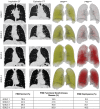Association between Functional Small Airway Disease and FEV1 Decline in Chronic Obstructive Pulmonary Disease
- PMID: 26808615
- PMCID: PMC5003216
- DOI: 10.1164/rccm.201511-2219OC
Association between Functional Small Airway Disease and FEV1 Decline in Chronic Obstructive Pulmonary Disease
Abstract
Rationale: The small conducting airways are the major site of airflow obstruction in chronic obstructive pulmonary disease and may precede emphysema development.
Objectives: We hypothesized a novel computed tomography (CT) biomarker of small airway disease predicts FEV1 decline.
Methods: We analyzed 1,508 current and former smokers from COPDGene with linear regression to assess predictors of change in FEV1 (ml/yr) over 5 years. Separate models for subjects without and with airflow obstruction were generated using baseline clinical and physiologic predictors in addition to two novel CT metrics created by parametric response mapping (PRM), a technique pairing inspiratory and expiratory CT images to define emphysema (PRM(emph)) and functional small airways disease (PRM(fSAD)), a measure of nonemphysematous air trapping.
Measurements and main results: Mean (SD) rate of FEV1 decline in ml/yr for GOLD (Global Initiative for Chronic Obstructive Lung Disease) 0-4 was as follows: 41.8 (47.7), 53.8 (57.1), 45.6 (61.1), 31.6 (43.6), and 5.1 (35.8), respectively (trend test for grades 1-4; P < 0.001). In multivariable linear regression, for participants without airflow obstruction, PRM(fSAD) but not PRM(emph) was associated with FEV1 decline (P < 0.001). In GOLD 1-4 participants, both PRM(fSAD) and PRM(emph) were associated with FEV1 decline (P < 0.001 and P = 0.001, respectively). Based on the model, the proportional contribution of the two CT metrics to FEV1 decline, relative to each other, was 87% versus 13% and 68% versus 32% for PRM(fSAD) and PRM(emph) in GOLD 1/2 and 3/4, respectively.
Conclusions: CT-assessed functional small airway disease and emphysema are associated with FEV1 decline, but the association with functional small airway disease has greatest importance in mild-to-moderate stage chronic obstructive pulmonary disease where the rate of FEV1 decline is the greatest. Clinical trial registered with www.clinicaltrials.gov (NCT 00608764).
Trial registration: ClinicalTrials.gov NCT00608764.
Keywords: FEV1; lung function; parametric response mapping.
Figures


Comment in
-
Small Airway Disease or Emphysema: Which Is More Important in Lung Function and FEV1 Decline? An Old Story with a New Twist.Am J Respir Crit Care Med. 2016 Jul 15;194(2):129-30. doi: 10.1164/rccm.201602-0197ED. Am J Respir Crit Care Med. 2016. PMID: 27420355 No abstract available.
-
Reply: FEV1 Decline in Patients with Chronic Obstructive Pulmonary Disease.Am J Respir Crit Care Med. 2017 Jun 15;195(12):1677. doi: 10.1164/rccm.201701-0127LE. Am J Respir Crit Care Med. 2017. PMID: 28170281 Free PMC article. No abstract available.
-
FEV1 Decline in Patients with Chronic Obstructive Pulmonary Disease.Am J Respir Crit Care Med. 2017 Jun 15;195(12):1676-1677. doi: 10.1164/rccm.201701-0001LE. Am J Respir Crit Care Med. 2017. PMID: 28170294 No abstract available.
References
-
- Mead J, Turner JM, Macklem PT, Little JB. Significance of the relationship between lung recoil and maximum expiratory flow. J Appl Physiol. 1967;22:95–108. - PubMed
-
- Hogg JC, Macklem PT, Thurlbeck WM. Site and nature of airway obstruction in chronic obstructive lung disease. N Engl J Med. 1968;278:1355–1360. - PubMed
-
- Yanai M, Sekizawa K, Ohrui T, Sasaki H, Takishima T. Site of airway obstruction in pulmonary disease: direct measurement of intrabronchial pressure. J Appl Physiol (1985) 1992;72:1016–1023. - PubMed
-
- Mead J. The lung’s “quiet zone.”. N Engl J Med. 1970;282:1318–1319. - PubMed
Publication types
MeSH terms
Associated data
Grants and funding
LinkOut - more resources
Full Text Sources
Other Literature Sources
Medical

